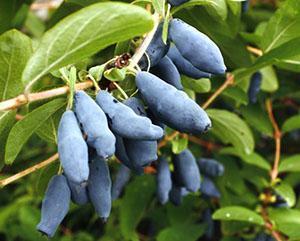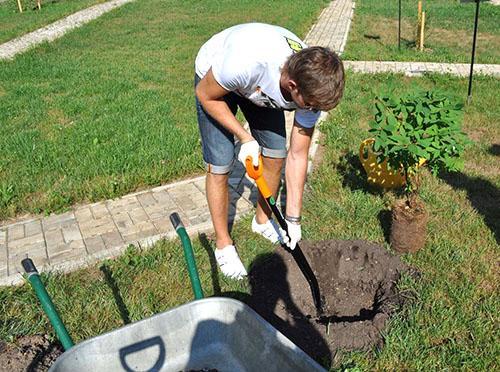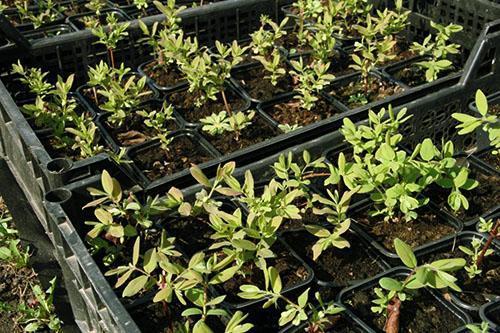Planting honeysuckle in summer cottages in Siberia
 An early tasty berry grown at their summer cottage is a real luxury for many Siberians. But not for those who are engaged in the cultivation of honeysuckle and have already managed to enjoy all the advantages of this fragrant berry. In the conditions of the arrival of late spring, it ripens in mid-June, when raspberries, strawberries, currants are just setting the buds.
An early tasty berry grown at their summer cottage is a real luxury for many Siberians. But not for those who are engaged in the cultivation of honeysuckle and have already managed to enjoy all the advantages of this fragrant berry. In the conditions of the arrival of late spring, it ripens in mid-June, when raspberries, strawberries, currants are just setting the buds.
Features of planting honeysuckle in Siberia

In order for a plant to successfully develop and bear fruit in a cold Siberian climate, you need to know how to plant honeysuckleso that she quickly acclimatizes:
- Choose only zoned varieties that are developed specifically for the Siberian region.
- For planting, three-year-old bushes in containers with an open root system are best suited. They are several times more expensive than annual seedlings, but they are more resistant to climatic conditions, they will take root faster after transshipment and will delight you with delicious berries in the first year.
Choosing the right healthy quality seedling is an art. Seedlings of strong three-year-old honeysuckle should have from three to four elastic branches up to 40 cm and a well-branched root system with a large presence of small light roots around the earthen coma. Before buying, it is advisable to dump the plant from the pot and inspect the ground. If there is no unpleasant smell of mold, and the earthy clod is securely held around the roots, then such a plant was well looked after in the nursery and it will quickly take root.
- It is better to prepare pits for planting in spring and fill them with long-playing mineral fertilizers, shovel the soil once a month. It is recommended to plant honeysuckle in a permanent place a month before the onset of frost. If the plant has an open root system, then it is better to carry out planting work in late spring or early summer, provided that it is cool, rainy weather. In this case, the bushes must be regularly watered and fruit set must be prevented.
- The planting hole must be made voluminous and deep (at least 1 meter). Over the summer, it will sag a little and fill with loose compost. It is convenient to plant plants in such a land, since it is already filled with all the nutrients and oxygen (subject to regular shoveling of the soil). The drainage system is best made from rough pebbles or cobblestones.
- The bush in the hole must be placed so that the ground spuds the lower branches of the plant.
- During planting, it is forbidden to apply fertilizer under the roots.
- The land around the planted plant is watered, tamped well and mulched. Sawdust, needles, compost are best suited as mulch, peat, fresh cut grass. Sphagnum moss grows in Siberian forests. It is an ideal mulch for berry bushes.In summer or autumn, you can also use straw, but for the winter it is better to replace it with pine branches.
- Do not overuse thickened plantings. A distance of one and a half meters in width between the bushes will allow the honeysuckle to fully develop and bear fruit.
- It is better to start feeding in a year, in small doses, after abundant watering.
Several varieties of honeysuckle in one area can significantly increase the yield.
 After planting, further care for honeysuckle consists in weeding, watering, as the soil dries out and preventive work. It is important not to overdo it with fertilization. This can lead to the death of the plant or severe exposure of the lower part of the trunk.
After planting, further care for honeysuckle consists in weeding, watering, as the soil dries out and preventive work. It is important not to overdo it with fertilization. This can lead to the death of the plant or severe exposure of the lower part of the trunk.
Secrets of honeysuckle: subtleties of care and successful wintering
 Caring for honeysuckle in Siberia is not much different from a similar process in another region of the country. A year after planting, the bushes should be regularly fed with complex fertilizers. But since the summer in this region is short, it is better to accelerate the supply of nutrients to the roots. To do this, deep holes are made in the near-stem circle of the bush with a crowbar and a solution with trace elements is poured into them. It is better to use nitrogen fertilizers only in early spring in minimal quantities, since the plant will not have time to completely absorb them in a short vegetative period. The dose of ammonium nitrate should not exceed 35 g per plant. Potassium and superphosphate applied in spring and autumn at the rate of 30 g per bush.
Caring for honeysuckle in Siberia is not much different from a similar process in another region of the country. A year after planting, the bushes should be regularly fed with complex fertilizers. But since the summer in this region is short, it is better to accelerate the supply of nutrients to the roots. To do this, deep holes are made in the near-stem circle of the bush with a crowbar and a solution with trace elements is poured into them. It is better to use nitrogen fertilizers only in early spring in minimal quantities, since the plant will not have time to completely absorb them in a short vegetative period. The dose of ammonium nitrate should not exceed 35 g per plant. Potassium and superphosphate applied in spring and autumn at the rate of 30 g per bush.
Honeysuckle is a simple and easy-care plant. It quickly takes root on the site and happily gives its fruits to people. Experienced gardeners have long found an approach to this plant and learned the secrets of honeysuckle, which will facilitate the care of the bushes and help increase the yield:
- Learn to water the honeysuckle properly. This plant does not tolerate waterlogging of the soil, but loves to drink in the heat. It is important not to miss watering in two growing periods of the bush: during flowering and at the beginning of mass ripening of fruits. If at this time the plant experiences a lack of moisture, it can lose 50% of the crop. Three large buckets of water will be enough to water an adult bush. It should be carefully and evenly distributed over the area of the trunk circle. When irrigating, you cannot use the wells for fertilizing. In this case, the top ball of the soil and the lobular root system will remain dry, and they most of all suffer from a lack of moisture.
- Honeysuckle is a slow-growing plant, and how many fertilizers and growth stimulants were not applied under it, there will not be a greater shoot growth of 5-6 cm per year in the Siberian climate. The plant reacts well to organic fertilizers and if possible, it is better to use them. Infusion of mullein (apply only in the spring) or chicken manure has a beneficial effect on the growth of young shoots, the quality of the harvest.
- July-October is the time when you can transplant honeysuckle to a new place without stress for the plant. Before transplanting, the land around the bush is watered, they wait for moisture to be absorbed and only then they begin to dig up the plant. It is necessary to grab as large a clod of earth as possible around the roots. This will allow the honeysuckle to resume growth faster.
- It is necessary to control the formation of the crown of the honeysuckle. Thinning of the bush and removal of old shoots should be started in the third year after planting. Thickened plants drastically lose their yield and decorative appearance. To achieve the best fruiting, it is worth shortening the branches of the plant to 20 cm. It is important that the lower part of the shoot is as illuminated as possible, since more flowers are laid there.
 A few simple tips can at times, better than any fertilizers and stimulants, increase the fruiting and growth of honeysuckle. If there are no skills in forming a bush and pruning plants, then watching a video about planting and caring for honeysuckle will help you cope with the task.
A few simple tips can at times, better than any fertilizers and stimulants, increase the fruiting and growth of honeysuckle. If there are no skills in forming a bush and pruning plants, then watching a video about planting and caring for honeysuckle will help you cope with the task.
Preparation of honeysuckle for winter in Siberia has its own characteristics. It is very important for a successful wintering:
- cut off all young, unripe shoots on the crown and remove old, diseased branches that will serve as sources of infection;
- mulch the near-trunk circle of the bush with spruce or pine branches, coniferous branches are the best protection against rodents and good organic feeding;
- lower shoots should be covered with earth.
There is one simple and effective answer to the question of how to prepare honeysuckle for winter: timely prevention of diseases, proper care strengthens the immune system of honeysuckle and help it to winter without losses and stress.
Honeysuckle in Siberia: the best varieties
 If you choose the right reliable zoned varieties of honeysuckle for Siberia, then summer will always start with a tasty and aromatic berry. When choosing, one should be guided by such criteria as:
If you choose the right reliable zoned varieties of honeysuckle for Siberia, then summer will always start with a tasty and aromatic berry. When choosing, one should be guided by such criteria as:
- high productivity;
- good winter hardiness;
- early fruiting.
Altai and Chinese honeysuckle meet these requirements and are close relatives of many valuable varieties released in the Siberian region.
Altai honeysuckle lives throughout Russia, widespread in the forests of the Far East, Siberia, the Urals, Altai. The plant grows well in bright places, open slopes. Fruiting of the bush begins in early June and ends in September. The berries have a characteristic blue color and bitter taste. On the basis of Altai honeysuckle, such varieties as “Berel”, “Fire Opal”, “Galochka, Selena”, “Sirius” have been created.
 Kamchatka honeysuckle is distinguished by its early maturity and good, sweet taste of the fruit, which tend to shedding during ripening. The slow growth of the bush and the late entry into the fruiting phase is the main disadvantage of the plant, but its high winter hardiness allowed scientists to develop on its basis such popular varieties as the Blue Spindle, Cinderella, Blue Bird, Iliada.
Kamchatka honeysuckle is distinguished by its early maturity and good, sweet taste of the fruit, which tend to shedding during ripening. The slow growth of the bush and the late entry into the fruiting phase is the main disadvantage of the plant, but its high winter hardiness allowed scientists to develop on its basis such popular varieties as the Blue Spindle, Cinderella, Blue Bird, Iliada.
Today, beneficial breeding work is being carried out in this direction, and the main goal of scientists is to create varieties of honeysuckle with a low level of shedding of fruits, high productivity and resistance to natural conditions.